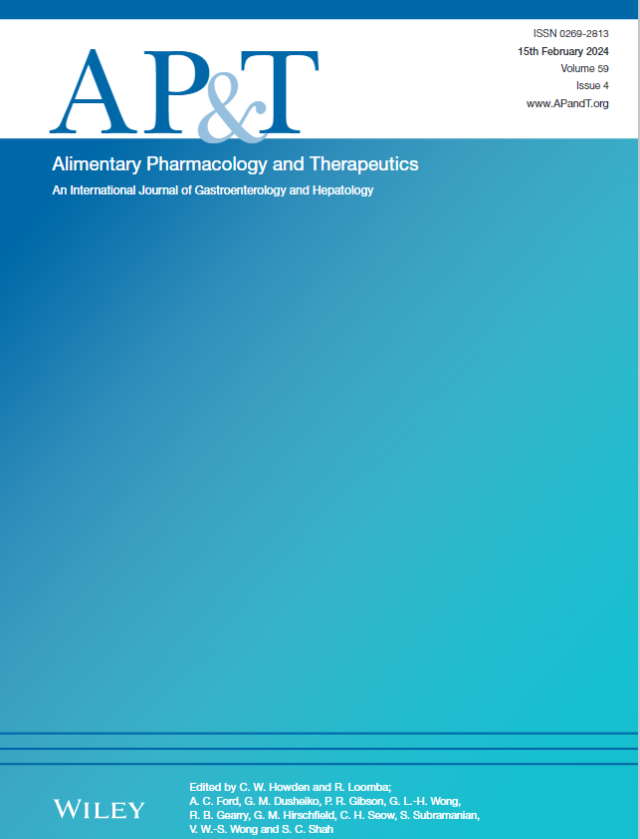Long-Term Dynamic Changes of Alanine Aminotransferase Levels Are Associated With Liver-Related Events in Nucleos(t)ide Analogue-Treated Chronic Hepatitis B Patients in China.
IF 6.6
1区 医学
Q1 GASTROENTEROLOGY & HEPATOLOGY
引用次数: 0
Abstract
BACKGROUND The role of alanine aminotransferase (ALT) dynamics during nucleos(t)ide analogue (NA) therapy in chronic hepatitis B (CHB) is unclear. We aimed to evaluate the correlation between ALT dynamics and liver-related events (LRE), and explore the optimal threshold of ALT during NA treatment. METHODS We enrolled 18,129 NA-treated patients, comprising 3104 patients from the Search-B study (NCT02167503) and 15,025 patients from a real-world cohort in Hong Kong. Latent-class mixed model (LCMM) was adopted to identify trajectory patterns of ALT during treatment. ALT value at the 95th percentile of the trajectory group with the lowest LRE risk was obtained as the optimal threshold. RESULTS During a median follow-up of 53.3 months, 1164 patients developed LRE with a 7-year cumulative incidence of 9.9%. In the Search-B cohort, LCMM recognised 3 trajectory groups with progressively increasing ALT levels, which were positively associated with LRE risk. Subsequently, the optimal thresholds for ALT were obtained as 23 U/L for men and 16 U/L for women. The 7-year cumulative incidence of LRE was 5.5% for ALT ≤ 23 or 16 U/L, significantly lower than that for ALT > 23 or 16 U/L but ≤ 40 U/L (10.8%; aHR = 2.0, p < 0.001), and ALT > 40 U/L (15.1%; aHR = 3.4, p < 0.001). Similarly, in the Hong Kong cohort, ALT > 23 or 16 U/L but < 40 U/L and ALT > 40 U/L also increased the LRE risk, with aHRs of 2.0 (p = 0.003) and 6.1 (p < 0.001), respectively. CONCLUSION On-treatment ALT levels were significantly correlated with the prognosis of CHB. ALT ≤ 23 U/L for men and ≤ 16 U/L for women were identified as the optimal thresholds during NA treatment, suggesting that CHB patients should strive for a lower ALT level beyond the traditional normal range.中国慢性乙型肝炎患者丙氨酸转氨酶水平的长期动态变化与肝脏相关事件相关
背景:丙氨酸转氨酶(ALT)动力学在核苷类似物(NA)治疗慢性乙型肝炎(CHB)中的作用尚不清楚。我们旨在评估ALT动态与肝脏相关事件(LRE)的相关性,并探讨NA治疗期间ALT的最佳阈值。方法:我们招募了18,129名接受na治疗的患者,其中包括来自Search-B研究(NCT02167503)的3104名患者和来自香港现实世界队列的15,025名患者。采用潜伏类混合模型(Latent-class mixed model, LCMM)识别治疗过程中ALT的轨迹模式。获得LRE风险最低的轨迹组第95百分位的ALT值作为最优阈值。结果在53.3个月的中位随访期间,1164例患者发生LRE, 7年累计发病率为9.9%。在Search-B队列中,LCMM识别出3个ALT水平逐渐升高的轨迹组,ALT水平与LRE风险呈正相关。随后,ALT的最佳阈值为男性23 U/L,女性16 U/L。ALT≤23或16u /L组LRE的7年累积发病率为5.5%,显著低于ALT≤23或16u /L组(10.8%);aHR = 2.0, p 40 U/L (15.1%);aHR = 3.4, p = 23或16 U/L,但40 U/L也会增加LRE风险,aHR分别为2.0 (p = 0.003)和6.1 (p < 0.001)。结论治疗期ALT水平与慢性乙型肝炎的预后有显著相关性。男性ALT≤23 U/L,女性ALT≤16 U/L为NA治疗的最佳阈值,提示CHB患者应努力在传统正常范围之外降低ALT水平。
本文章由计算机程序翻译,如有差异,请以英文原文为准。
求助全文
约1分钟内获得全文
求助全文
来源期刊
CiteScore
15.60
自引率
7.90%
发文量
527
审稿时长
3-6 weeks
期刊介绍:
Alimentary Pharmacology & Therapeutics is a global pharmacology journal focused on the impact of drugs on the human gastrointestinal and hepato-biliary systems. It covers a diverse range of topics, often with immediate clinical relevance to its readership.

 求助内容:
求助内容: 应助结果提醒方式:
应助结果提醒方式:


